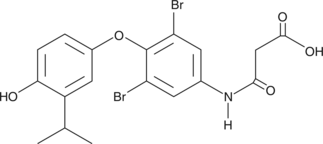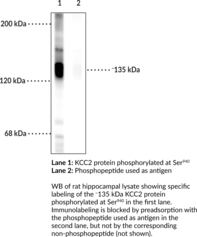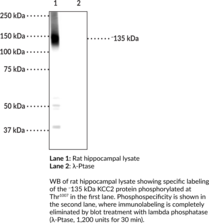Cayman
Showing 26251–26400 of 45550 results
-
The thyroid hormones, thyroxine (T4) and triiodothyronine (T3), promote the reduction of plasma cholesterol levels and induce weight loss. However when administered in high doses, thyroid hormones produce undesirable side effects in the heart, bone and muscle. KB2115 is a synthetic thyroid hormone mimetic. At a dose of 50-200 µg administered to humans once-daily for 14 days, KB2115 lowers total and low-density lipoprotein cholesterol up to 40% without affecting high-density lipoprotein cholesterol levels and without deleterious side effects to the cardiovascular system.{15145} Unlike the statin class of drugs which decrease cholesterol synthesis, KB2115 stimulates cholesterol catabolism to bile acids without affecting cholesterol synthesis.{15145}
Brand:CaymanSKU:10011054 - 5 mgAvailable on backorder
The thyroid hormones, thyroxine (T4) and triiodothyronine (T3), promote the reduction of plasma cholesterol levels and induce weight loss. However when administered in high doses, thyroid hormones produce undesirable side effects in the heart, bone and muscle. KB2115 is a synthetic thyroid hormone mimetic. At a dose of 50-200 µg administered to humans once-daily for 14 days, KB2115 lowers total and low-density lipoprotein cholesterol up to 40% without affecting high-density lipoprotein cholesterol levels and without deleterious side effects to the cardiovascular system.{15145} Unlike the statin class of drugs which decrease cholesterol synthesis, KB2115 stimulates cholesterol catabolism to bile acids without affecting cholesterol synthesis.{15145}
Brand:CaymanSKU:10011054 - 500 µgAvailable on backorder
KBC-007 is a synthetic branched chain-containing analog of α-galactosylceramide (α-GalCer).{46100,46099} It induces IL-4 and IFN-γ secretion by mouse splenocytes when used at a concentration of 0.5 ng/ml and IL-2 secretion by DN32.D3 NKT hybridoma cells co-cultured with CD1d-transfected RBL cells pre-loaded with KBC-007 at a concentration of 8 ng/ml.{46100} KBC-007 (1 μg per animal) increases levels of IL-4, but not IFN-γ, to a similar degree as α-GalCer in mouse serum. KBC-007 (0.5 μg per animal) increases the survival rate of mice immunized with the inactivated influenza A virus A/PR/8/34 in a model of influenza infection. {46099}
Brand:CaymanSKU:26661 - 100 µgAvailable on backorder
KBC-007 is a synthetic branched chain-containing analog of α-galactosylceramide (α-GalCer).{46100,46099} It induces IL-4 and IFN-γ secretion by mouse splenocytes when used at a concentration of 0.5 ng/ml and IL-2 secretion by DN32.D3 NKT hybridoma cells co-cultured with CD1d-transfected RBL cells pre-loaded with KBC-007 at a concentration of 8 ng/ml.{46100} KBC-007 (1 μg per animal) increases levels of IL-4, but not IFN-γ, to a similar degree as α-GalCer in mouse serum. KBC-007 (0.5 μg per animal) increases the survival rate of mice immunized with the inactivated influenza A virus A/PR/8/34 in a model of influenza infection. {46099}
Brand:CaymanSKU:26661 - 50 µgAvailable on backorder
ABHD16A (also known as HLA-B associated transcript 5 (BAT5)) is a phosphatidylserine hydrolase that regulates the formation of lysophosphatidylserines (lyso-PSs) and has been implicated in certain immunological and neurological diseases.{28160} KC01 is a covalent inhibitor of ABHD16A (IC50s = 90 and 520 nM for human and mouse, respectively).{28160} It has been shown to deplete lyso-PS from various human cancer cell lines, a lymphoblast cell line, and mouse brain membrane lysates and to decrease LPS-induced cytokine production in macrophages.{28160} This compound has been used to characterize the role of ABHD16A as a principle phosphatidylserine lipase in vivo.{28160}
Brand:CaymanSKU:-Available on backorder
ABHD16A (also known as HLA-B associated transcript 5 (BAT5)) is a phosphatidylserine hydrolase that regulates the formation of lysophosphatidylserines (lyso-PSs) and has been implicated in certain immunological and neurological diseases.{28160} KC01 is a covalent inhibitor of ABHD16A (IC50s = 90 and 520 nM for human and mouse, respectively).{28160} It has been shown to deplete lyso-PS from various human cancer cell lines, a lymphoblast cell line, and mouse brain membrane lysates and to decrease LPS-induced cytokine production in macrophages.{28160} This compound has been used to characterize the role of ABHD16A as a principle phosphatidylserine lipase in vivo.{28160}
Brand:CaymanSKU:-Available on backorder
KC02 is an inactive control probe for KC01 (Item No. 17364), the potent inhibitor of ABHD16A, a phosphatidylserine hydrolase that regulates the formation of lysophosphatidylserines in mammalian systems. KC02 demonstrates IC50 values greater 10 µM against human and mouse ABHD16A.{28160}
Brand:CaymanSKU:-Available on backorder
KC02 is an inactive control probe for KC01 (Item No. 17364), the potent inhibitor of ABHD16A, a phosphatidylserine hydrolase that regulates the formation of lysophosphatidylserines in mammalian systems. KC02 demonstrates IC50 values greater 10 µM against human and mouse ABHD16A.{28160}
Brand:CaymanSKU:-Available on backorder
KC02 is an inactive control probe for KC01 (Item No. 17364), the potent inhibitor of ABHD16A, a phosphatidylserine hydrolase that regulates the formation of lysophosphatidylserines in mammalian systems. KC02 demonstrates IC50 values greater 10 µM against human and mouse ABHD16A.{28160}
Brand:CaymanSKU:-Available on backorder
Hypoxia-inducible factor-1 (HIF-1) is a heterodimeric transcription factor composed of a HIF-1α subunit and HIF-1β subunit. The HIF-1α subunit is regulated by cellular oxygen levels and therefore plays an important role in maintaining cellular oxygen homeostasis.{11044,12428} KC7F2 is an inhibitor of HIF-1α protein translation, but not transcription, that suppresses phosphorylation of two key regulators of protein synthesis, eukaryotic translation initiation factor 4E binding protein 1 (4EBP1) and p70 S6 kinase (S6K).{23550} It inhibits hypoxia-induced expression of several HIF target genes, such as carbonic anhydrase IX, matrix metalloproteinase 2, enolase 1, and endothelin 1. KC7F2 is cytotoxic to a variety of cancer cell lines with an IC50 value of 15-25 µM.{23550}
Brand:CaymanSKU:-Hypoxia-inducible factor-1 (HIF-1) is a heterodimeric transcription factor composed of a HIF-1α subunit and HIF-1β subunit. The HIF-1α subunit is regulated by cellular oxygen levels and therefore plays an important role in maintaining cellular oxygen homeostasis.{11044,12428} KC7F2 is an inhibitor of HIF-1α protein translation, but not transcription, that suppresses phosphorylation of two key regulators of protein synthesis, eukaryotic translation initiation factor 4E binding protein 1 (4EBP1) and p70 S6 kinase (S6K).{23550} It inhibits hypoxia-induced expression of several HIF target genes, such as carbonic anhydrase IX, matrix metalloproteinase 2, enolase 1, and endothelin 1. KC7F2 is cytotoxic to a variety of cancer cell lines with an IC50 value of 15-25 µM.{23550}
Brand:CaymanSKU:-Hypoxia-inducible factor-1 (HIF-1) is a heterodimeric transcription factor composed of a HIF-1α subunit and HIF-1β subunit. The HIF-1α subunit is regulated by cellular oxygen levels and therefore plays an important role in maintaining cellular oxygen homeostasis.{11044,12428} KC7F2 is an inhibitor of HIF-1α protein translation, but not transcription, that suppresses phosphorylation of two key regulators of protein synthesis, eukaryotic translation initiation factor 4E binding protein 1 (4EBP1) and p70 S6 kinase (S6K).{23550} It inhibits hypoxia-induced expression of several HIF target genes, such as carbonic anhydrase IX, matrix metalloproteinase 2, enolase 1, and endothelin 1. KC7F2 is cytotoxic to a variety of cancer cell lines with an IC50 value of 15-25 µM.{23550}
Brand:CaymanSKU:-Immunogen: Phosphopeptide corresponding to amino acid residues surrounding the phospho-Ser940 of rat KCC2 • Host: Rabbit • Species Reactivity: (+) Mouse, Rat • Cross Reactivity: (+) KCC2 (phospho-Ser940); (-) Non-phosphorylated KCC2 • Applications: WB • MW = ~135 kDa
Brand:CaymanSKU:29291- 100 µlThe neuronal-specific potassium chloride cotransporter 2 (KCC2) is a member of the SLC12 family of transporters and is encoded by SLC12A5 in humans.{55121} KCC2 is expressed in mature neurons throughout the CNS and localizes to the soma and dendrite plasma membrane where it mediates chloride ion efflux, maintaining the transmembrane chloride potential.{55122} It consists of 12 transmembrane helices, which contain an extracellular loop subject to N-glycosylation, as well as intracellular N- and C-terminal domains with sites that are subject to phosphorylation. Phosphorylation of KCC2 at serine 940 (Ser940) is mediated by PKC and regulates KCC2 stability and expression.{55121,55123} KCC2 (phospho-Ser940) levels are increased by the PKC activator phorbol 12-myristate 13-acetate (PMA; Item No. 10008014) in primary rat embryonic hippocampal neurons.{55123} HEK293 cells expressing a point mutation of Ser940 (S940A) in KCC2, which abolishes its phosphorylation, have a reduced rate of ion transport and decreased KCC2 endocytosis. Mice expressing S940A have reduced latency to first seizure and increased mortality in a mouse model of status epilepticus induced by kainate.{55124} Cayman’s KCC2 (Phospho-Ser940) Polyclonal Antibody can be used for Western blot (WB) applications. The antibody recognizes KCC2 (Phospho-Ser940) at approximately 135 kDa from mouse and rat samples.
Brand:CaymanSKU:29291 - 100 µlAvailable on backorder
Immunogen: Phosphopeptide corresponding to amino acid residues surrounding the phospho-Ser940 of rat KCC2 • Host: Rabbit • Species Reactivity: (+) Mouse, Rat • Cross Reactivity: (+) KCC2 (phospho-Ser940); (-) Non-phosphorylated KCC2 • Applications: WB • MW = ~135 kDa
Brand:CaymanSKU:29291- 100 µlAvailable on backorder
Immunogen: Phosphopeptide corresponding to amino acid residues surrounding the phospho-Thr1007 of mouse KCC2 • Host: Rabbit • Species Reactivity: (+) Mouse, Rat • Cross Reactivity: (+) KCC2 (phospho-Thr1007); (-) Unphosphorylated KCC2 • Applications: WB • MW = ~135 kDa
Brand:CaymanSKU:29292- 100 µlThe neuronal-specific potassium chloride cotransporter 2 (KCC2) is a member of the SLC12 family of transporters and is encoded by SLC12A5 in humans.{55121} KCC2 is expressed in mature neurons throughout the CNS and localizes to the soma and dendrite plasma membrane where it mediates chloride ion efflux, maintaining the transmembrane chloride potential.{55122} It consists of 12 transmembrane helices, which contain an extracellular loop subject to N-glycosylation, as well as intracellular N- and C-terminal domains with sites that are subject to phosphorylation. Phosphorylation of KCC2 at threonine 1007 (Thr1007) is mediated by lysine-deficient protein kinase 1 (WNK1) and its effectors, STE20/SPS1-related proline-alanine-rich protein kinase (SPAK) and oxidative stress-responsive kinase 1 (OSR1), resulting in reduced KCC2 activity. Phospho-Thr1007 levels are decreased by the KCC2 activator N-ethylmaleimide (NEM) in HEK293 cells.{59146} Point mutation of Thr1007 (T1007E) in KCC2 mimics its phosphorylation and abolishes NEM-induced chloride ion efflux in HEK293 cells. Cayman’s KCC2 (Phospho-Thr1007) Polyclonal Antibody can be used for Western blot (WB) applications. The antibody recognizes KCC2 (phospho-Thr1007) at approximately 135 kDa from mouse and rat samples.
Brand:CaymanSKU:29292 - 100 µlAvailable on backorder
Immunogen: Phosphopeptide corresponding to amino acid residues surrounding the phospho-Thr1007 of mouse KCC2 • Host: Rabbit • Species Reactivity: (+) Mouse, Rat • Cross Reactivity: (+) KCC2 (phospho-Thr1007); (-) Unphosphorylated KCC2 • Applications: WB • MW = ~135 kDa
Brand:CaymanSKU:29292- 100 µlAvailable on backorder
Ion channels are integral membrane proteins that help establish and control the small voltage gradient across the plasma membrane of living cells by allowing the flow of ions down their electrochemical gradient.{17533} They are present in the membranes that surround all biological cells and their main function is to regulate the flow of ions across this membrane. Whereas some ion channels permit the passage of ions based on charge, others conduct based on a ionic species, such as sodium or potassium. Furthermore, in some ion channels, the passage is governed by a gate which is controlled by chemical or electrical signals, temperature, or mechanical forces. There are a few main classifications of gated ion channels. There are voltage-gated ion channels, ligand-gated, other gating systems, and finally those that are classified differently, having more exotic characteristics. The first are voltage-gated ion channels which open and close in response to membrane potential. These are then seperated into sodium, calcium, potassium, proton, transient receptor, and cyclic nucleotide-gated channels, each of which is responsible for a unique role. Ligand-gated ion channels are also known as ionotropic receptors and they open in response to specific ligand molecules binding to the extracellular domain of the receptor protein. The other gated classifications include activation and inactivation by second messengers, inward-rectifier potassium channels, calcium-activated potassium channels, two-pore-domain potassium channels, light-gated channels, mechano-sensitive ion channels, and cyclic nucleotide-gated channels. Finally, the other classifications are based on less normal characteristics such as two-pore channels and transient receptor potential channels.{17535} Kv7.1 (KvLQT1) is a potassium channel protein coded by the gene KCNQ1. Kv7.1 is present in the cell membranes of cardiac muscle tissue and in inner ear neurons among other tissues.{17651} In the cardiac cells, Kv7.1 mediates the IKs (or slow delayed rectifying potassium) current that contributes to the repolarization of the cell, terminating the cardiac action potential and thereby the heart’s contraction.{17652,17653}
Brand:CaymanSKU:13711 - 100 µgAvailable on backorder
Antigen: fusion protein amino acids 2-101 of human KCNQ1 • Host: mouse, clone S37A-10 • Isotype: IgG1 • Cross Reactivity: (+) human, mouse, and rat KCNQ1 • Application(s): ICC, IHC, IP, and WB • Kv7.1 (KvLQT1) is a potassium channel protein coded by the gene KCNQ1. Kv7.1 is present in the cell membranes of cardiac muscle tissue and in inner ear neurons among other tissues. In the cardiac cells, Kv7.1 mediates the IKs (or slow delayed rectifying potassium) current that contributes to the repolarization of the cell, terminating the cardiac action potential and thereby the heart’s contraction.
Brand:CaymanSKU:13711- 100 µgAvailable on backorder
Antigen: fusion protein amino acids 2-101 of human KCNQ1 • Host: mouse, clone S37A-10 • Isotype: IgG1 • Cross Reactivity: (+) human, mouse, and rat KCNQ1 • Application(s): ICC, IHC, IP, and WB • Kv7.1 (KvLQT1) is a potassium channel protein coded by the gene KCNQ1. Kv7.1 is present in the cell membranes of cardiac muscle tissue and in inner ear neurons among other tissues. In the cardiac cells, Kv7.1 mediates the IKs (or slow delayed rectifying potassium) current that contributes to the repolarization of the cell, terminating the cardiac action potential and thereby the heart’s contraction.
Brand:CaymanSKU:13711- 100 µgIon channels are integral membrane proteins that help establish and control the small voltage gradient across the plasma membrane of living cells by allowing the flow of ions down their electrochemical gradient.{17533} They are present in the membranes that surround all biological cells and their main function is to regulate the flow of ions across this membrane. Whereas some ion channels permit the passage of ions based on charge, others conduct based on a ionic species, such as sodium or potassium. Furthermore, in some ion channels, the passage is governed by a gate which is controlled by chemical or electrical signals, temperature, or mechanical forces. There are a few main classifications of gated ion channels. There are voltage-gated ion channels, ligand-gated, other gating systems, and finally those that are classified differently, having more exotic characteristics. The first are voltage-gated ion channels which open and close in response to membrane potential. These are then seperated into sodium, calcium, potassium, proton, transient receptor, and cyclic nucleotide-gated channels, each of which is responsible for a unique role. Ligand-gated ion channels are also known as ionotropic receptors and they open in response to specific ligand molecules binding to the extracellular domain of the receptor protein. The other gated classifications include activation and inactivation by second messengers, inward-rectifier potassium channels, calcium-activated potassium channels, two-pore-domain potassium channels, light-gated channels, mechano-sensitive ion channels, and cyclic nucleotide-gated channels. Finally, the other classifications are based on less normal characteristics such as two-pore channels and transient receptor potential channels.{17535} Kv7.1 (KvLQT1) is a potassium channel protein coded by the gene KCNQ1. It is associated with benign familial neonatal convulsions.{17654}
Brand:CaymanSKU:13712 - 100 µgAvailable on backorder
Antigen: fusion protein amino acids 1-59 of human KCNQ2 • Host: mouse, clone S26A-23 • Isotype: IgG1 • Cross Reactivity: (+) human, mouse, and rat KCNQ2 • Application(s): ICC, IHC, IP, and WB • Kv7.1 (KvLQT1) is a potassium channel protein coded by the gene KCNQ1. It is associated with benign familial neonatal convulsions.
Brand:CaymanSKU:13712- 100 µgAvailable on backorder
Antigen: fusion protein amino acids 1-59 of human KCNQ2 • Host: mouse, clone S26A-23 • Isotype: IgG1 • Cross Reactivity: (+) human, mouse, and rat KCNQ2 • Application(s): ICC, IHC, IP, and WB • Kv7.1 (KvLQT1) is a potassium channel protein coded by the gene KCNQ1. It is associated with benign familial neonatal convulsions.
Brand:CaymanSKU:13712- 100 µgIon channels are integral membrane proteins that help establish and control the small voltage gradient across the plasma membrane of living cells by allowing the flow of ions down their electrochemical gradient.{17533} They are present in the membranes that surround all biological cells and their main function is to regulate the flow of ions across this membrane. Whereas some ion channels permit the passage of ions based on charge, others conduct based on a ionic species, such as sodium or potassium. Furthermore, in some ion channels, the passage is governed by a gate which is controlled by chemical or electrical signals, temperature, or mechanical forces. There are a few main classifications of gated ion channels. There are voltage-gated ion channels, ligand-gated, other gating systems, and finally those that are classified differently, having more exotic characteristics. The first are voltage-gated ion channels which open and close in response to membrane potential. These are then seperated into sodium, calcium, potassium, proton, transient receptor, and cyclic nucleotide-gated channels, each of which is responsible for a unique role. Ligand-gated ion channels are also known as ionotropic receptors and they open in response to specific ligand molecules binding to the extracellular domain of the receptor protein. The other gated classifications include activation and inactivation by second messengers, inward-rectifier potassium channels, calcium-activated potassium channels, two-pore-domain potassium channels, light-gated channels, mechano-sensitive ion channels, and cyclic nucleotide-gated channels. Finally, the other classifications are based on less normal characteristics such as two-pore channels and transient receptor potential channels.{17535} The protein encoded by this gene forms a potassium channel that is thought to play a critical role in the regulation of neuronal excitability, particularly in sensory cells of the cochlea.{17657,17658} The current generated by this channel is inhibited by M1 muscarinic acetylcholine receptors and is activated by retigabine, a novel anti-convulsant drug.{17659}
Brand:CaymanSKU:13713 - 100 µgAvailable on backorder
Antigen: fusion protein amino acids 2-77 of human KCNQ4 • Host: mouse, clone S43-6 • Isotype: IgG1 • Cross Reactivity: (+) human, mouse, and rat KCNQ4 • Application(s): ICC, IP, and WB • The protein encoded by this gene forms a potassium channel that is thought to play a critical role in the regulation of neuronal excitability, particularly in sensory cells of the cochlea. The current generated by this channel is inhibited by M1 muscarinic acetylcholine receptors and is activated by retigabine, a novel anti-convulsant drug.
Brand:CaymanSKU:13713- 100 µgAvailable on backorder
Antigen: fusion protein amino acids 2-77 of human KCNQ4 • Host: mouse, clone S43-6 • Isotype: IgG1 • Cross Reactivity: (+) human, mouse, and rat KCNQ4 • Application(s): ICC, IP, and WB • The protein encoded by this gene forms a potassium channel that is thought to play a critical role in the regulation of neuronal excitability, particularly in sensory cells of the cochlea. The current generated by this channel is inhibited by M1 muscarinic acetylcholine receptors and is activated by retigabine, a novel anti-convulsant drug.
Brand:CaymanSKU:13713- 100 µgRho-associated protein kinase II (ROCK-II) regulates the formation of actin stress fibers and focal adhesions, smooth muscle contraction, and gene expression. KD 025 is an orally bioavailable inhibitor of ROCK-II that is greater than 200-fold selective over ROCK-I (IC50s = 105 nM and 24 µM, respectively).{28734} Treatment of fibrosis-derived smooth muscle cells with KD 025 (40 µM) for 24 hours reduces the expression of connective tissue growth factor and remodels actin cytoskeleton.{28734} KD 025 decreases cell-spanning F-actin fibers and increases motility of microvascular endoethelial cells.{28735} In mice, KD 025 given by oral gavage dose-dependently reduces infarct volume after transient middle cerebral artery occlusion without causing significant hypotension.{28736} In humans, oral KD 025 diminishes STAT3 phosphorylation and pro-inflammatory cytokine production in CD4+ T cells while up-regulating phosphorylation of STAT5 in regulatory T cells, altering the immune response.{27716}
Brand:CaymanSKU:-Out of stock
Rho-associated protein kinase II (ROCK-II) regulates the formation of actin stress fibers and focal adhesions, smooth muscle contraction, and gene expression. KD 025 is an orally bioavailable inhibitor of ROCK-II that is greater than 200-fold selective over ROCK-I (IC50s = 105 nM and 24 µM, respectively).{28734} Treatment of fibrosis-derived smooth muscle cells with KD 025 (40 µM) for 24 hours reduces the expression of connective tissue growth factor and remodels actin cytoskeleton.{28734} KD 025 decreases cell-spanning F-actin fibers and increases motility of microvascular endoethelial cells.{28735} In mice, KD 025 given by oral gavage dose-dependently reduces infarct volume after transient middle cerebral artery occlusion without causing significant hypotension.{28736} In humans, oral KD 025 diminishes STAT3 phosphorylation and pro-inflammatory cytokine production in CD4+ T cells while up-regulating phosphorylation of STAT5 in regulatory T cells, altering the immune response.{27716}
Brand:CaymanSKU:-Out of stock
Rho-associated protein kinase II (ROCK-II) regulates the formation of actin stress fibers and focal adhesions, smooth muscle contraction, and gene expression. KD 025 is an orally bioavailable inhibitor of ROCK-II that is greater than 200-fold selective over ROCK-I (IC50s = 105 nM and 24 µM, respectively).{28734} Treatment of fibrosis-derived smooth muscle cells with KD 025 (40 µM) for 24 hours reduces the expression of connective tissue growth factor and remodels actin cytoskeleton.{28734} KD 025 decreases cell-spanning F-actin fibers and increases motility of microvascular endoethelial cells.{28735} In mice, KD 025 given by oral gavage dose-dependently reduces infarct volume after transient middle cerebral artery occlusion without causing significant hypotension.{28736} In humans, oral KD 025 diminishes STAT3 phosphorylation and pro-inflammatory cytokine production in CD4+ T cells while up-regulating phosphorylation of STAT5 in regulatory T cells, altering the immune response.{27716}
Brand:CaymanSKU:-Out of stock
Rho-associated protein kinase II (ROCK-II) regulates the formation of actin stress fibers and focal adhesions, smooth muscle contraction, and gene expression. KD 025 is an orally bioavailable inhibitor of ROCK-II that is greater than 200-fold selective over ROCK-I (IC50s = 105 nM and 24 µM, respectively).{28734} Treatment of fibrosis-derived smooth muscle cells with KD 025 (40 µM) for 24 hours reduces the expression of connective tissue growth factor and remodels actin cytoskeleton.{28734} KD 025 decreases cell-spanning F-actin fibers and increases motility of microvascular endoethelial cells.{28735} In mice, KD 025 given by oral gavage dose-dependently reduces infarct volume after transient middle cerebral artery occlusion without causing significant hypotension.{28736} In humans, oral KD 025 diminishes STAT3 phosphorylation and pro-inflammatory cytokine production in CD4+ T cells while up-regulating phosphorylation of STAT5 in regulatory T cells, altering the immune response.{27716}
Brand:CaymanSKU:-Out of stock
KD 5170 is a mercaptoketone-based inhibitor of class I and II histone deacetylases (HDACs; IC50s = 20, 2,060, 75, 26, 950, 14, 85, 2,500, 150, and 18 nM for HDAC1-10, respectively).{33761} It exhibits broad spectrum antitumor activity in vitro and in vivo.{33761,33760,16850} KD 5170 increases the acetylation of histones and activates caspases 3, 8, and 9, leading to apoptosis in primary myeloma cells.{33760}
Brand:CaymanSKU:-KD 5170 is a mercaptoketone-based inhibitor of class I and II histone deacetylases (HDACs; IC50s = 20, 2,060, 75, 26, 950, 14, 85, 2,500, 150, and 18 nM for HDAC1-10, respectively).{33761} It exhibits broad spectrum antitumor activity in vitro and in vivo.{33761,33760,16850} KD 5170 increases the acetylation of histones and activates caspases 3, 8, and 9, leading to apoptosis in primary myeloma cells.{33760}
Brand:CaymanSKU:-KD 5170 is a mercaptoketone-based inhibitor of class I and II histone deacetylases (HDACs; IC50s = 20, 2,060, 75, 26, 950, 14, 85, 2,500, 150, and 18 nM for HDAC1-10, respectively).{33761} It exhibits broad spectrum antitumor activity in vitro and in vivo.{33761,33760,16850} KD 5170 increases the acetylation of histones and activates caspases 3, 8, and 9, leading to apoptosis in primary myeloma cells.{33760}
Brand:CaymanSKU:-KD 5170 is a mercaptoketone-based inhibitor of class I and II histone deacetylases (HDACs; IC50s = 20, 2,060, 75, 26, 950, 14, 85, 2,500, 150, and 18 nM for HDAC1-10, respectively).{33761} It exhibits broad spectrum antitumor activity in vitro and in vivo.{33761,33760,16850} KD 5170 increases the acetylation of histones and activates caspases 3, 8, and 9, leading to apoptosis in primary myeloma cells.{33760}
Brand:CaymanSKU:-Oxidized low-density lipoprotein (oxLDL) particles contain low molecular weight species which are cytotoxic and pro-atherogenic.{9800} Many of these substances were recently isolated and purified from oxLDL, and identified as phosphatidylcholine species containing a fragmented, oxidized short-chain fatty acid remnant at the sn-2 position.{9891} KDdiA-PC is one of the most potent CD36 ligands among the oxLDL species.{9890} KDdiA-PC confers CD-36 scavenger receptor binding affinity to LDL at a frequency of only two to three KDdiA-PC molecules/LDL particle, and may be one of the more important structural determinants of oxLDL.
Brand:CaymanSKU:62935 - 1 mgAvailable on backorder
Oxidized low-density lipoprotein (oxLDL) particles contain low molecular weight species which are cytotoxic and pro-atherogenic.{9800} Many of these substances were recently isolated and purified from oxLDL, and identified as phosphatidylcholine species containing a fragmented, oxidized short-chain fatty acid remnant at the sn-2 position.{9891} KDdiA-PC is one of the most potent CD36 ligands among the oxLDL species.{9890} KDdiA-PC confers CD-36 scavenger receptor binding affinity to LDL at a frequency of only two to three KDdiA-PC molecules/LDL particle, and may be one of the more important structural determinants of oxLDL.
Brand:CaymanSKU:62935 - 10 mgAvailable on backorder
Oxidized low-density lipoprotein (oxLDL) particles contain low molecular weight species which are cytotoxic and pro-atherogenic.{9800} Many of these substances were recently isolated and purified from oxLDL, and identified as phosphatidylcholine species containing a fragmented, oxidized short-chain fatty acid remnant at the sn-2 position.{9891} KDdiA-PC is one of the most potent CD36 ligands among the oxLDL species.{9890} KDdiA-PC confers CD-36 scavenger receptor binding affinity to LDL at a frequency of only two to three KDdiA-PC molecules/LDL particle, and may be one of the more important structural determinants of oxLDL.
Brand:CaymanSKU:62935 - 5 mgAvailable on backorder
Oxidized low-density lipoprotein (oxLDL) particles contain low molecular weight species which are cytotoxic and pro-atherogenic.{9800} Many of these substances were recently isolated and purified from oxLDL, and identified as phosphatidylcholine species containing a fragmented, oxidized short-chain fatty acid remnant at the sn-2 position.{9891} KDdiA-PC is one of the most potent CD36 ligands among the oxLDL species.{9890} KDdiA-PC confers CD-36 scavenger receptor binding affinity to LDL at a frequency of only two to three KDdiA-PC molecules/LDL particle, and may be one of the more important structural determinants of oxLDL.
Brand:CaymanSKU:62935 - 500 µgAvailable on backorder
KDU691 is an antimalarial compound.{53056} It inhibits recombinant P. vivax phosphatidylinositol 4-kinase (PI4K) with an IC50 value of 1.5 nM. KDU691 is selective for P. vivax PI4K over recombinant human PI4KβIII and PI3Kα, -β, -ɣ, and -δ (IC50s = 7.9, 8.8, 2.4, 8, and 3.4 µM, respectively), as well as VPS34 (IC50 = >9.7 µM) and 36 additional kinases in a panel of lipid and protein kinases (IC50s = >10 µM). It is active against P. falciparum and P. yoelii schizonts (IC50s = 0.06 and 0.04 µM, respectively), as well as P. cynomolgi schizonts and hypnozoites (IC50s = 0.11 and 0.2 µM, respectively).{53057} KDU691 completely prevents, but does not eradicate established, P. cynomolgi infection in rhesus monkeys when administered at a dose of 20 mg/kg.{53058}
Brand:CaymanSKU:29019 - 1 mgAvailable on backorder
KDU691 is an antimalarial compound.{53056} It inhibits recombinant P. vivax phosphatidylinositol 4-kinase (PI4K) with an IC50 value of 1.5 nM. KDU691 is selective for P. vivax PI4K over recombinant human PI4KβIII and PI3Kα, -β, -ɣ, and -δ (IC50s = 7.9, 8.8, 2.4, 8, and 3.4 µM, respectively), as well as VPS34 (IC50 = >9.7 µM) and 36 additional kinases in a panel of lipid and protein kinases (IC50s = >10 µM). It is active against P. falciparum and P. yoelii schizonts (IC50s = 0.06 and 0.04 µM, respectively), as well as P. cynomolgi schizonts and hypnozoites (IC50s = 0.11 and 0.2 µM, respectively).{53057} KDU691 completely prevents, but does not eradicate established, P. cynomolgi infection in rhesus monkeys when administered at a dose of 20 mg/kg.{53058}
Brand:CaymanSKU:29019 - 10 mgAvailable on backorder
KDU691 is an antimalarial compound.{53056} It inhibits recombinant P. vivax phosphatidylinositol 4-kinase (PI4K) with an IC50 value of 1.5 nM. KDU691 is selective for P. vivax PI4K over recombinant human PI4KβIII and PI3Kα, -β, -ɣ, and -δ (IC50s = 7.9, 8.8, 2.4, 8, and 3.4 µM, respectively), as well as VPS34 (IC50 = >9.7 µM) and 36 additional kinases in a panel of lipid and protein kinases (IC50s = >10 µM). It is active against P. falciparum and P. yoelii schizonts (IC50s = 0.06 and 0.04 µM, respectively), as well as P. cynomolgi schizonts and hypnozoites (IC50s = 0.11 and 0.2 µM, respectively).{53057} KDU691 completely prevents, but does not eradicate established, P. cynomolgi infection in rhesus monkeys when administered at a dose of 20 mg/kg.{53058}
Brand:CaymanSKU:29019 - 25 mgAvailable on backorder
KDU691 is an antimalarial compound.{53056} It inhibits recombinant P. vivax phosphatidylinositol 4-kinase (PI4K) with an IC50 value of 1.5 nM. KDU691 is selective for P. vivax PI4K over recombinant human PI4KβIII and PI3Kα, -β, -ɣ, and -δ (IC50s = 7.9, 8.8, 2.4, 8, and 3.4 µM, respectively), as well as VPS34 (IC50 = >9.7 µM) and 36 additional kinases in a panel of lipid and protein kinases (IC50s = >10 µM). It is active against P. falciparum and P. yoelii schizonts (IC50s = 0.06 and 0.04 µM, respectively), as well as P. cynomolgi schizonts and hypnozoites (IC50s = 0.11 and 0.2 µM, respectively).{53057} KDU691 completely prevents, but does not eradicate established, P. cynomolgi infection in rhesus monkeys when administered at a dose of 20 mg/kg.{53058}
Brand:CaymanSKU:29019 - 5 mgAvailable on backorder
Kemptide is a synthetic heptapeptide that acts as a specific substrate for cAMP-dependent protein kinase (PKA) as it carries the recognition and phosphorylation site of PKA.{25574} Various cultured cells can catalyze the phosphorylation of kemptide in the presence of extracellular ATP and cAMP (Kms = 3-4 μM) with plasma membranes remaining intact.{25574}
Brand:CaymanSKU:-Kemptide is a synthetic heptapeptide that acts as a specific substrate for cAMP-dependent protein kinase (PKA) as it carries the recognition and phosphorylation site of PKA.{25574} Various cultured cells can catalyze the phosphorylation of kemptide in the presence of extracellular ATP and cAMP (Kms = 3-4 μM) with plasma membranes remaining intact.{25574}
Brand:CaymanSKU:-Kemptide is a synthetic heptapeptide that acts as a specific substrate for cAMP-dependent protein kinase (PKA) as it carries the recognition and phosphorylation site of PKA.{25574} Various cultured cells can catalyze the phosphorylation of kemptide in the presence of extracellular ATP and cAMP (Kms = 3-4 μM) with plasma membranes remaining intact.{25574}
Brand:CaymanSKU:-Kemptide is a synthetic heptapeptide that acts as a specific substrate for cAMP-dependent protein kinase (PKA) as it carries the recognition and phosphorylation site of PKA.{25574} Various cultured cells can catalyze the phosphorylation of kemptide in the presence of extracellular ATP and cAMP (Kms = 3-4 μM) with plasma membranes remaining intact.{25574}
Brand:CaymanSKU:-Kendomycin is a macrolide from Streptomyces which displays potent cytotoxicity against several carcinoma cell lines (GI50 < 100 nM).{20722} It also acts as an endothelin receptor antagonist and has antiosteoporotic activities.{20722} Certain effects are thought to be mediated through inhibition of proteasomal degradation of proteins.
Brand:CaymanSKU:11037 - 100 µgAvailable on backorder
Kendomycin is a macrolide from Streptomyces which displays potent cytotoxicity against several carcinoma cell lines (GI50 < 100 nM).{20722} It also acts as an endothelin receptor antagonist and has antiosteoporotic activities.{20722} Certain effects are thought to be mediated through inhibition of proteasomal degradation of proteins.
Brand:CaymanSKU:11037 - 500 µgAvailable on backorder
The development of selective, cell-permeable protein kinase inhibitors for the treatment of cancer, inflammation, and other diseases, is a major focus of drug development efforts. Kenpaullone is an ATP-competitive inhibitor of several cyclin-dependent kinases (CDKs) as well as glycogen synthase kinase 3β (GSK3β).{14993,14995,14994} It inhibits GSK3β with an IC50 value of 0.023 µM{14994} (0.23 µM){14995} and Cdk1/cyclin B, Cdk2/cyclin A, Cdk5/p25, and lymphocyte kinase with IC50 values of 0.4, 0.68, 0.85, and 0.47 µM, respectively.{14993}
Brand:CaymanSKU:10010239 - 1 mgAvailable on backorder
The development of selective, cell-permeable protein kinase inhibitors for the treatment of cancer, inflammation, and other diseases, is a major focus of drug development efforts. Kenpaullone is an ATP-competitive inhibitor of several cyclin-dependent kinases (CDKs) as well as glycogen synthase kinase 3β (GSK3β).{14993,14995,14994} It inhibits GSK3β with an IC50 value of 0.023 µM{14994} (0.23 µM){14995} and Cdk1/cyclin B, Cdk2/cyclin A, Cdk5/p25, and lymphocyte kinase with IC50 values of 0.4, 0.68, 0.85, and 0.47 µM, respectively.{14993}
Brand:CaymanSKU:10010239 - 10 mgAvailable on backorder
The development of selective, cell-permeable protein kinase inhibitors for the treatment of cancer, inflammation, and other diseases, is a major focus of drug development efforts. Kenpaullone is an ATP-competitive inhibitor of several cyclin-dependent kinases (CDKs) as well as glycogen synthase kinase 3β (GSK3β).{14993,14995,14994} It inhibits GSK3β with an IC50 value of 0.023 µM{14994} (0.23 µM){14995} and Cdk1/cyclin B, Cdk2/cyclin A, Cdk5/p25, and lymphocyte kinase with IC50 values of 0.4, 0.68, 0.85, and 0.47 µM, respectively.{14993}
Brand:CaymanSKU:10010239 - 25 mgAvailable on backorder
The development of selective, cell-permeable protein kinase inhibitors for the treatment of cancer, inflammation, and other diseases, is a major focus of drug development efforts. Kenpaullone is an ATP-competitive inhibitor of several cyclin-dependent kinases (CDKs) as well as glycogen synthase kinase 3β (GSK3β).{14993,14995,14994} It inhibits GSK3β with an IC50 value of 0.023 µM{14994} (0.23 µM){14995} and Cdk1/cyclin B, Cdk2/cyclin A, Cdk5/p25, and lymphocyte kinase with IC50 values of 0.4, 0.68, 0.85, and 0.47 µM, respectively.{14993}
Brand:CaymanSKU:10010239 - 5 mgAvailable on backorder
Keracyanin (chloride) is a polyphenolic anthocyanin found naturally in many plants.{25982} It has high antioxidant activity, protecting erythrocytes from apoptosis.{25982,25983} However, keracyanin (chloride) impairs growth and induces apoptosis in the highly tumorigenic RE-149 DHD cell line.{25984} It inhibits a range of mammalian and bacterial proteases, including neutrophil elastase, matrix metalloproteinase-1 (MMP-1), and MMP-9 at concentrations of 6.25-50 µg/ml.{25981} When added to food, keracyanin (chloride) significantly reduces body weight gain, resistance to insulin, and lipid accumulation in mice fed a high-fat diet.{25985}
Brand:CaymanSKU:-Keracyanin (chloride) is a polyphenolic anthocyanin found naturally in many plants.{25982} It has high antioxidant activity, protecting erythrocytes from apoptosis.{25982,25983} However, keracyanin (chloride) impairs growth and induces apoptosis in the highly tumorigenic RE-149 DHD cell line.{25984} It inhibits a range of mammalian and bacterial proteases, including neutrophil elastase, matrix metalloproteinase-1 (MMP-1), and MMP-9 at concentrations of 6.25-50 µg/ml.{25981} When added to food, keracyanin (chloride) significantly reduces body weight gain, resistance to insulin, and lipid accumulation in mice fed a high-fat diet.{25985}
Brand:CaymanSKU:-Ketamine hydroxylimine precursor (hydrochloride) (Item No. 22213) is an analytical reference standard categorized as a precursor in the synthesis of ketamine (Item Nos. 19389 | 11630).{58115} This product is intended for research and forensic applications.
Brand:CaymanSKU:22213 -Out of stock
Ketamine hydroxylimine precursor (hydrochloride) (Item No. 22213) is an analytical reference standard categorized as a precursor in the synthesis of ketamine (Item Nos. 19389 | 11630).{58115} This product is intended for research and forensic applications.
Brand:CaymanSKU:22213 -Out of stock
Ketanserin is a potent antagonist of the serotonin (5-HT) receptor that is selective for 5-HT2 (IC50 = 6.3 nM; Ki = 2.1 nM).{40001} It has no activity at 5-HT1 receptors but does have activity at histamine type 1, α1-adrenergic, and dopamine receptors with Ki values of 10, 10, and 220 nM, respectively. Ketanserin induces dose-dependent inhibition of contractile responses to 5-HT in isolated rat caudal artery, canine basilar, carotid, coronary and gastrosplenic arteries, and canine gastrosplenic and saphenous veins.{40003} Ketanserin (10 mg/kg/day) significantly decreases blood pressure (BP), blood pressure variability (BPV), and hypertensive organ damage in spontaneously hypertensive rats.{40002} Formulations containing ketanserin have been used to treat hypertension in early-onset preeclampsia.{40000}
Brand:CaymanSKU:22058 -Out of stock
Ketanserin is a potent antagonist of the serotonin (5-HT) receptor that is selective for 5-HT2 (IC50 = 6.3 nM; Ki = 2.1 nM).{40001} It has no activity at 5-HT1 receptors but does have activity at histamine type 1, α1-adrenergic, and dopamine receptors with Ki values of 10, 10, and 220 nM, respectively. Ketanserin induces dose-dependent inhibition of contractile responses to 5-HT in isolated rat caudal artery, canine basilar, carotid, coronary and gastrosplenic arteries, and canine gastrosplenic and saphenous veins.{40003} Ketanserin (10 mg/kg/day) significantly decreases blood pressure (BP), blood pressure variability (BPV), and hypertensive organ damage in spontaneously hypertensive rats.{40002} Formulations containing ketanserin have been used to treat hypertension in early-onset preeclampsia.{40000}
Brand:CaymanSKU:22058 -Out of stock
Ketanserin is a potent antagonist of the serotonin (5-HT) receptor that is selective for 5-HT2 (IC50 = 6.3 nM; Ki = 2.1 nM).{40001} It has no activity at 5-HT1 receptors but does have activity at histamine type 1, α1-adrenergic, and dopamine receptors with Ki values of 10, 10, and 220 nM, respectively. Ketanserin induces dose-dependent inhibition of contractile responses to 5-HT in isolated rat caudal artery, canine basilar, carotid, coronary and gastrosplenic arteries, and canine gastrosplenic and saphenous veins.{40003} Ketanserin (10 mg/kg/day) significantly decreases blood pressure (BP), blood pressure variability (BPV), and hypertensive organ damage in spontaneously hypertensive rats.{40002} Formulations containing ketanserin have been used to treat hypertension in early-onset preeclampsia.{40000}
Brand:CaymanSKU:22058 -Out of stock
Ketanserin is a potent antagonist of the serotonin (5-HT) receptor that is selective for 5-HT2 (IC50 = 6.3 nM; Ki = 2.1 nM).{40001} It has no activity at 5-HT1 receptors but does have activity at histamine type 1, α1-adrenergic, and dopamine receptors with Ki values of 10, 10, and 220 nM, respectively. Ketanserin induces dose-dependent inhibition of contractile responses to 5-HT in isolated rat caudal artery, canine basilar, carotid, coronary and gastrosplenic arteries, and canine gastrosplenic and saphenous veins.{40003} Ketanserin (10 mg/kg/day) significantly decreases blood pressure (BP), blood pressure variability (BPV), and hypertensive organ damage in spontaneously hypertensive rats.{40002} Formulations containing ketanserin have been used to treat hypertension in early-onset preeclampsia.{40000}
Brand:CaymanSKU:22058 -Out of stock
Ketoconazole is a broad-spectrum triazole antifungal agent that has activity against C. albicans, C. krusei, C. tropicalis, C. glabrata, C. parapsilosis, C. neoformans, and A. fumigatus strains (IC50s = 0.031-8 µg/ml).{24649} It inhibits the fungal cytochrome P450 (CYP) isoform CYP51, also known as lanosterol 14α-demethylase, which arrests ergosterol (Item No. 19850) biosynthesis at the fungal membrane. Ketoconazole also inhibits human CYP3A4 (IC50 = 0.54 µM). Formulations containing ketoconazole have been used in the treatment of fungal infections.
Brand:CaymanSKU:-Ketoconazole is a broad-spectrum triazole antifungal agent that has activity against C. albicans, C. krusei, C. tropicalis, C. glabrata, C. parapsilosis, C. neoformans, and A. fumigatus strains (IC50s = 0.031-8 µg/ml).{24649} It inhibits the fungal cytochrome P450 (CYP) isoform CYP51, also known as lanosterol 14α-demethylase, which arrests ergosterol (Item No. 19850) biosynthesis at the fungal membrane. Ketoconazole also inhibits human CYP3A4 (IC50 = 0.54 µM). Formulations containing ketoconazole have been used in the treatment of fungal infections.
Brand:CaymanSKU:-Ketoconazole is a broad-spectrum triazole antifungal agent that has activity against C. albicans, C. krusei, C. tropicalis, C. glabrata, C. parapsilosis, C. neoformans, and A. fumigatus strains (IC50s = 0.031-8 µg/ml).{24649} It inhibits the fungal cytochrome P450 (CYP) isoform CYP51, also known as lanosterol 14α-demethylase, which arrests ergosterol (Item No. 19850) biosynthesis at the fungal membrane. Ketoconazole also inhibits human CYP3A4 (IC50 = 0.54 µM). Formulations containing ketoconazole have been used in the treatment of fungal infections.
Brand:CaymanSKU:-Ketoconazole is a broad-spectrum triazole antifungal agent that has activity against C. albicans, C. krusei, C. tropicalis, C. glabrata, C. parapsilosis, C. neoformans, and A. fumigatus strains (IC50s = 0.031-8 µg/ml).{24649} It inhibits the fungal cytochrome P450 (CYP) isoform CYP51, also known as lanosterol 14α-demethylase, which arrests ergosterol (Item No. 19850) biosynthesis at the fungal membrane. Ketoconazole also inhibits human CYP3A4 (IC50 = 0.54 µM). Formulations containing ketoconazole have been used in the treatment of fungal infections.
Brand:CaymanSKU:-Ketoconazole-d3 is intended for use as an internal standard for the quantification of ketoconazole (Item No. 15212) by GC- or LC-MS. Ketoconazole is a broad-spectrum triazole antifungal agent that has activity against C. albicans, C. krusei, C. tropicalis, C. glabrata, C. parapsilosis, C. neoformans, and A. fumigatus strains (IC50s = 0.031-8 μg/ml).{24649} It inhibits the fungal cytochrome P450 (CYP) isoform CYP51, also known as lanosterol 14α-demethylase, which arrests ergosterol (Item No. 19850) biosynthesis at the fungal membrane. Ketoconazole also inhibits human CYP3A4 (IC50 = 0.54 μM). Formulations containing ketoconazole have been used in the treatment of fungal infections.
Brand:CaymanSKU:10010656 - 1 mgAvailable on backorder
Ketoconazole-d3 is intended for use as an internal standard for the quantification of ketoconazole (Item No. 15212) by GC- or LC-MS. Ketoconazole is a broad-spectrum triazole antifungal agent that has activity against C. albicans, C. krusei, C. tropicalis, C. glabrata, C. parapsilosis, C. neoformans, and A. fumigatus strains (IC50s = 0.031-8 μg/ml).{24649} It inhibits the fungal cytochrome P450 (CYP) isoform CYP51, also known as lanosterol 14α-demethylase, which arrests ergosterol (Item No. 19850) biosynthesis at the fungal membrane. Ketoconazole also inhibits human CYP3A4 (IC50 = 0.54 μM). Formulations containing ketoconazole have been used in the treatment of fungal infections.
Brand:CaymanSKU:10010656 - 5 mgAvailable on backorder
Ketoconazole-d3 is intended for use as an internal standard for the quantification of ketoconazole (Item No. 15212) by GC- or LC-MS. Ketoconazole is a broad-spectrum triazole antifungal agent that has activity against C. albicans, C. krusei, C. tropicalis, C. glabrata, C. parapsilosis, C. neoformans, and A. fumigatus strains (IC50s = 0.031-8 μg/ml).{24649} It inhibits the fungal cytochrome P450 (CYP) isoform CYP51, also known as lanosterol 14α-demethylase, which arrests ergosterol (Item No. 19850) biosynthesis at the fungal membrane. Ketoconazole also inhibits human CYP3A4 (IC50 = 0.54 μM). Formulations containing ketoconazole have been used in the treatment of fungal infections.
Brand:CaymanSKU:10010656 - 500 µgAvailable on backorder
Ketorolac is a non-steroidal anti-inflammatory drug (NSAID) and a non-selective COX inhibitor (IC50 = 20 nM for both COX-1 and COX-2).{6065} It prevents increases in paw swelling, increases paw withdrawal latency in a hot-plate test, and decreases prostaglandin E2 (PGE2) levels in paw tissue in a mouse model of carrageenan-induced inflammation when administered at a dose of 30 mg/kg. Ketorolac is a racemic mixture containing the active (S)-ketorolac (Item No. 11348) and inactive (R)-ketorolac enantiomers. Formulations containing ketorolac have been used to manage postoperative pain and as ophthalmic solutions to treat ocular pain and inflammation.
Brand:CaymanSKU:9001148 - 1 gAvailable on backorder
Ketorolac is a non-steroidal anti-inflammatory drug (NSAID) and a non-selective COX inhibitor (IC50 = 20 nM for both COX-1 and COX-2).{6065} It prevents increases in paw swelling, increases paw withdrawal latency in a hot-plate test, and decreases prostaglandin E2 (PGE2) levels in paw tissue in a mouse model of carrageenan-induced inflammation when administered at a dose of 30 mg/kg. Ketorolac is a racemic mixture containing the active (S)-ketorolac (Item No. 11348) and inactive (R)-ketorolac enantiomers. Formulations containing ketorolac have been used to manage postoperative pain and as ophthalmic solutions to treat ocular pain and inflammation.
Brand:CaymanSKU:9001148 - 100 mgAvailable on backorder
Ketorolac is a non-steroidal anti-inflammatory drug (NSAID) and a non-selective COX inhibitor (IC50 = 20 nM for both COX-1 and COX-2).{6065} It prevents increases in paw swelling, increases paw withdrawal latency in a hot-plate test, and decreases prostaglandin E2 (PGE2) levels in paw tissue in a mouse model of carrageenan-induced inflammation when administered at a dose of 30 mg/kg. Ketorolac is a racemic mixture containing the active (S)-ketorolac (Item No. 11348) and inactive (R)-ketorolac enantiomers. Formulations containing ketorolac have been used to manage postoperative pain and as ophthalmic solutions to treat ocular pain and inflammation.
Brand:CaymanSKU:9001148 - 50 mgAvailable on backorder
Ketorolac is a non-steroidal anti-inflammatory drug (NSAID) and a non-selective COX inhibitor (IC50 = 20 nM for both COX-1 and COX-2).{6065} It prevents increases in paw swelling, increases paw withdrawal latency in a hot-plate test, and decreases prostaglandin E2 (PGE2) levels in paw tissue in a mouse model of carrageenan-induced inflammation when administered at a dose of 30 mg/kg. Ketorolac is a racemic mixture containing the active (S)-ketorolac (Item No. 11348) and inactive (R)-ketorolac enantiomers. Formulations containing ketorolac have been used to manage postoperative pain and as ophthalmic solutions to treat ocular pain and inflammation.
Brand:CaymanSKU:9001148 - 500 mgAvailable on backorder
Ketorolac is a non-steroidal anti-inflammatory drug (NSAID) and a non-selective COX inhibitor (IC50 = 20 nM for both COX-1 and COX-2).{6065} It prevents increases in paw swelling, increases paw withdrawal latency in a hot-plate test, and decreases prostaglandin E2 (PGE2) levels in paw tissue in a mouse model of carrageenan-induced inflammation when administered at a dose of 30 mg/kg. Ketorolac is a racemic mixture containing the active (S)-ketorolac (Item No. 11348) and inactive (R)-ketorolac enantiomers. Formulations containing ketorolac have been used to manage postoperative pain and as ophthalmic solutions to treat ocular pain and inflammation.
Brand:CaymanSKU:9003475 - 1 gAvailable on backorder
Ketorolac is a non-steroidal anti-inflammatory drug (NSAID) and a non-selective COX inhibitor (IC50 = 20 nM for both COX-1 and COX-2).{6065} It prevents increases in paw swelling, increases paw withdrawal latency in a hot-plate test, and decreases prostaglandin E2 (PGE2) levels in paw tissue in a mouse model of carrageenan-induced inflammation when administered at a dose of 30 mg/kg. Ketorolac is a racemic mixture containing the active (S)-ketorolac (Item No. 11348) and inactive (R)-ketorolac enantiomers. Formulations containing ketorolac have been used to manage postoperative pain and as ophthalmic solutions to treat ocular pain and inflammation.
Brand:CaymanSKU:9003475 - 100 mgAvailable on backorder
Ketorolac is a non-steroidal anti-inflammatory drug (NSAID) and a non-selective COX inhibitor (IC50 = 20 nM for both COX-1 and COX-2).{6065} It prevents increases in paw swelling, increases paw withdrawal latency in a hot-plate test, and decreases prostaglandin E2 (PGE2) levels in paw tissue in a mouse model of carrageenan-induced inflammation when administered at a dose of 30 mg/kg. Ketorolac is a racemic mixture containing the active (S)-ketorolac (Item No. 11348) and inactive (R)-ketorolac enantiomers. Formulations containing ketorolac have been used to manage postoperative pain and as ophthalmic solutions to treat ocular pain and inflammation.
Brand:CaymanSKU:9003475 - 250 mgAvailable on backorder
Ketorolac is a non-steroidal anti-inflammatory drug (NSAID) and a non-selective COX inhibitor (IC50 = 20 nM for both COX-1 and COX-2).{6065} It prevents increases in paw swelling, increases paw withdrawal latency in a hot-plate test, and decreases prostaglandin E2 (PGE2) levels in paw tissue in a mouse model of carrageenan-induced inflammation when administered at a dose of 30 mg/kg. Ketorolac is a racemic mixture containing the active (S)-ketorolac (Item No. 11348) and inactive (R)-ketorolac enantiomers. Formulations containing ketorolac have been used to manage postoperative pain and as ophthalmic solutions to treat ocular pain and inflammation.
Brand:CaymanSKU:9003475 - 500 mgAvailable on backorder
Ketorolac is a non-steroidal anti-inflammatory drug (NSAID) and a non-selective COX inhibitor (IC50 = 20 nM for both COX-1 and COX-2).{6065} It prevents increases in paw swelling, increases paw withdrawal latency in a hot-plate test, and decreases prostaglandin E2 (PGE2) levels in paw tissue in a mouse model of carrageenan-induced inflammation when administered at a dose of 30 mg/kg. Ketorolac is a racemic mixture containing the active (S)-ketorolac (Item No. 11348) and inactive (R)-ketorolac enantiomers. Formulations containing ketorolac have been used to manage postoperative pain and as ophthalmic solutions to treat ocular pain and inflammation.
Brand:CaymanSKU:70690 - 1 gAvailable on backorder
Ketorolac is a non-steroidal anti-inflammatory drug (NSAID) and a non-selective COX inhibitor (IC50 = 20 nM for both COX-1 and COX-2).{6065} It prevents increases in paw swelling, increases paw withdrawal latency in a hot-plate test, and decreases prostaglandin E2 (PGE2) levels in paw tissue in a mouse model of carrageenan-induced inflammation when administered at a dose of 30 mg/kg. Ketorolac is a racemic mixture containing the active (S)-ketorolac (Item No. 11348) and inactive (R)-ketorolac enantiomers. Formulations containing ketorolac have been used to manage postoperative pain and as ophthalmic solutions to treat ocular pain and inflammation.
Brand:CaymanSKU:70690 - 10 gAvailable on backorder
Ketorolac is a non-steroidal anti-inflammatory drug (NSAID) and a non-selective COX inhibitor (IC50 = 20 nM for both COX-1 and COX-2).{6065} It prevents increases in paw swelling, increases paw withdrawal latency in a hot-plate test, and decreases prostaglandin E2 (PGE2) levels in paw tissue in a mouse model of carrageenan-induced inflammation when administered at a dose of 30 mg/kg. Ketorolac is a racemic mixture containing the active (S)-ketorolac (Item No. 11348) and inactive (R)-ketorolac enantiomers. Formulations containing ketorolac have been used to manage postoperative pain and as ophthalmic solutions to treat ocular pain and inflammation.
Brand:CaymanSKU:70690 - 25 gAvailable on backorder
Ketorolac-d5 is intended for use as an internal standard for the quantification of ketorolac (Item No. 9001148) by GC- or LC-MS. Ketorolac is a non-steroidal anti-inflammatory drug (NSAID) and a non-selective COX inhibitor (IC50 = 20 nM for both COX-1 and COX-2).{6065} It prevents increases in paw swelling, increases paw withdrawal latency in a hot-plate test, and decreases prostaglandin E2 (PGE2) levels in paw tissue in a mouse model of carrageenan-induced inflammation when administered at a dose of 30 mg/kg. Ketorolac is a racemic mixture containing the active (S)-ketorolac (Item No. 11348) and inactive (R)-ketorolac enantiomers. Formulations containing ketorolac have been used to manage postoperative pain and as ophthalmic solutions to treat ocular pain and inflammation.
Brand:CaymanSKU:26454 - 1 mgAvailable on backorder
Ketorolac-d5 is intended for use as an internal standard for the quantification of ketorolac (Item No. 9001148) by GC- or LC-MS. Ketorolac is a non-steroidal anti-inflammatory drug (NSAID) and a non-selective COX inhibitor (IC50 = 20 nM for both COX-1 and COX-2).{6065} It prevents increases in paw swelling, increases paw withdrawal latency in a hot-plate test, and decreases prostaglandin E2 (PGE2) levels in paw tissue in a mouse model of carrageenan-induced inflammation when administered at a dose of 30 mg/kg. Ketorolac is a racemic mixture containing the active (S)-ketorolac (Item No. 11348) and inactive (R)-ketorolac enantiomers. Formulations containing ketorolac have been used to manage postoperative pain and as ophthalmic solutions to treat ocular pain and inflammation.
Brand:CaymanSKU:26454 - 500 µgAvailable on backorder






















